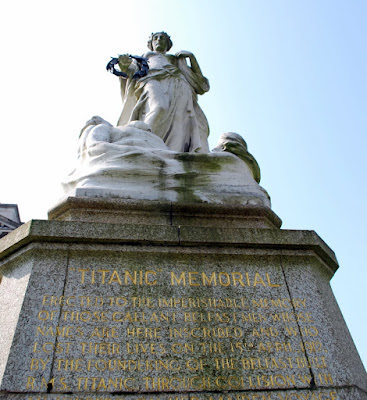Belfast is the capital of Northern Ireland and a city which grew during the industrial revolution with flourishing linen, rope-making, and shipbuilding industries. Most heavy industry has been replaced by services, technology and tourism in this modern day. I took this photo of the city from my hotel window as I loved the green rolling hills in the background that surround the city.
Belfast was the largest and most productive shipyard in the world at one time and the city's main shipbuilders, Harland and Wolff, built the ill-fated RMS Titanic. Although shipbuilding has been in a steady decline the twin Harland and Wolff yellow shipbuilding gantry cranes situated at Queen's Island, in Belfast, are nicknamed "Samson and Goliath," and still dominate the skyline as landmark structures of the city.
Memories of the Titanic are a large part of the city. This beautiful memorial was painted on the side of a building.
Since April 14, 2012, will be the 100th anniversary of the sinking of the Titanic, the city is gearing up with a Titanic Quarter and a Titanic Museum being constructed located at the head of Titanic’s original slipway. It will be the heart of a new revitalized area in East Belfast. The museum will tell the story of the people of Belfast as well as the story of the infamous ship.
Along with its industrial side, Belfast has much Victorian elegance to see as well as modern buildings and conveniences. Here are a few landmarks I found interesting:
The Albert Memorial Clock was erected in 1865 to commemorate Queen Victoria’s consort, Prince Albert is built on land reclaimed from the River Lagan. The clock leans slightly and has been called Belfast's "leaning tower of Pisa."
Belfast City Hall is the civic building of the Belfast City Council. Plans for the City Hall began in 1888 when Belfast was awarded city status by Queen Victoria.
The Titanic Memorial stands on the side of city hall.
The shopping area of Donegall Place is now home to 8 copper lighting masts. These feature lighting masts have been designed to create a significant impact on the street while taking in to account the historic setting. They have been influenced by Belfast’s industrial heritage, the linen industry and maritime traditions
The Grand Opera House of Belfast was built in 1895, and has delivered an unrivalled program of entertainment, playing host to some of the greatest names in theatre and music. It became the first building in Belfast to be listed as being of historical and architectural importance, and was acquired by the Arts Council of Northern Ireland in 1976.
Saint George's Market is one of Belfast’s oldest attractions. It was built between 1890 and 1896 and is one of the best markets in the UK and Ireland
Victoria Square shopping mall is one of the many wonderful shopping venues within Belfast.
It has a breathtaking urban design with four floors and a central communications area to take shoppers to different levels including a viewing gallery at the top from which to view the city.
Looking up at the Victoria Square viewing platform inside the dome.
Stormont Estate and Parliament building is the seat of the Northern Ireland Assembly and the Northern Ireland Executive.
‘The Searcher’, a statue sculpted by local artist Ross Wilson, was commissioned to mark the centenary of the birth of CS Lewis, author of "The Chronicles of Narnia." It stands outside Holywood Arches library, near to where Lewis grew up. It shows Professor Digory Kirke, hero of ‘The Magician’s Nephew’, entering the magical wardrobe into Narnia.
A close up of the sculpture.
Belfast is a very walkable city and while I took the "hop on hop off bus" to see some of the sights much of it I saw by foot. I'll show you more interesting sights in my next few posts...the historical pubs, some of the inside of city hall, and a library that dates back to 1788, and the remaining traces of the "Troubles" that has unfortunately plagued the city.
I'm linking to "Outdoor Wednesday" on Susan's blog A Southern Daydreamer. Click on the link to see links to all the blogs participating this week.
















